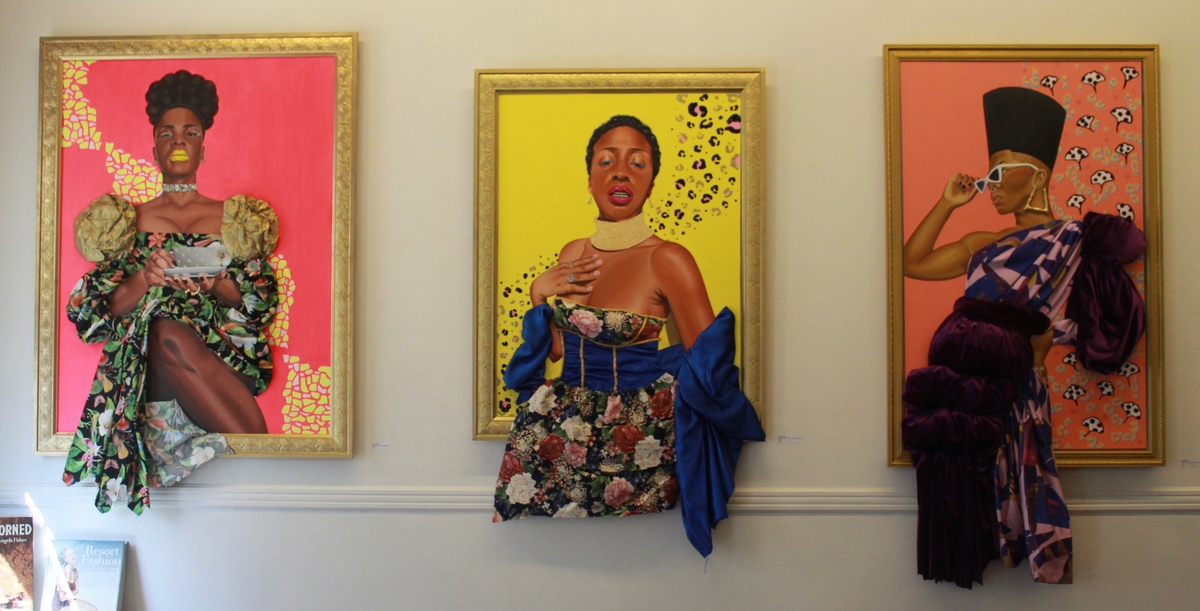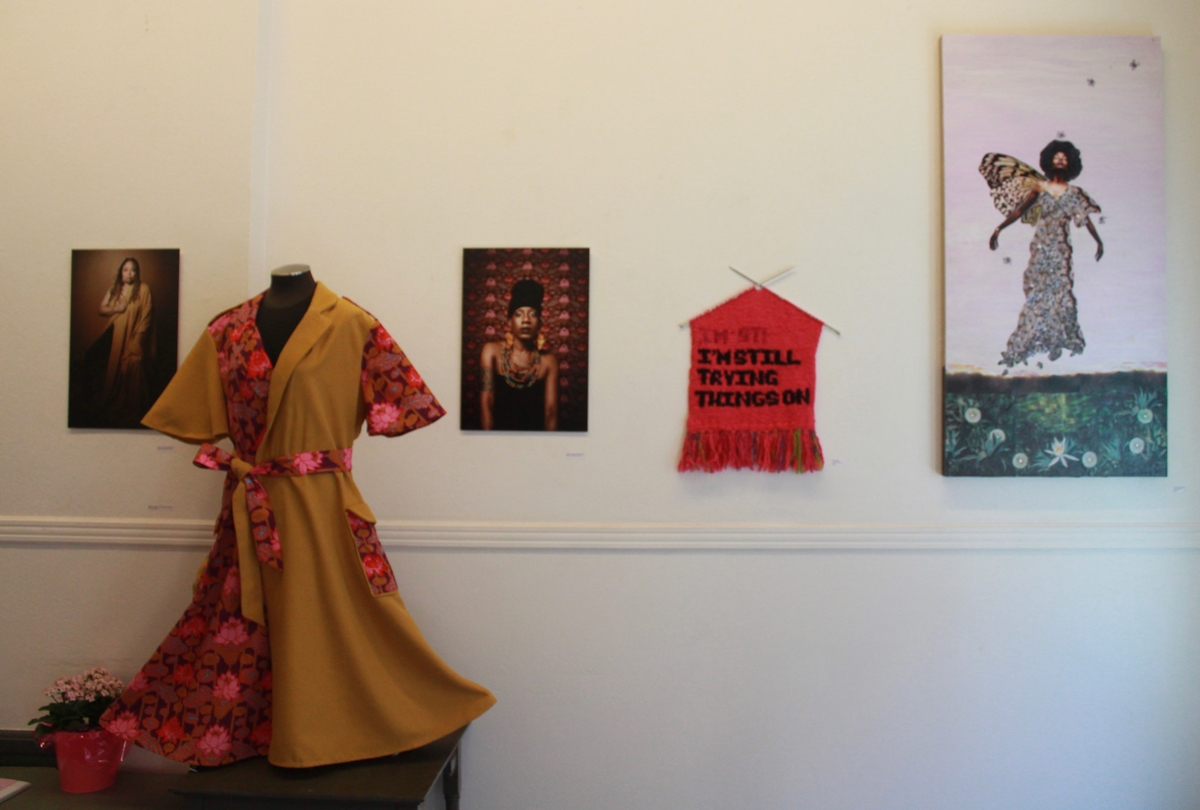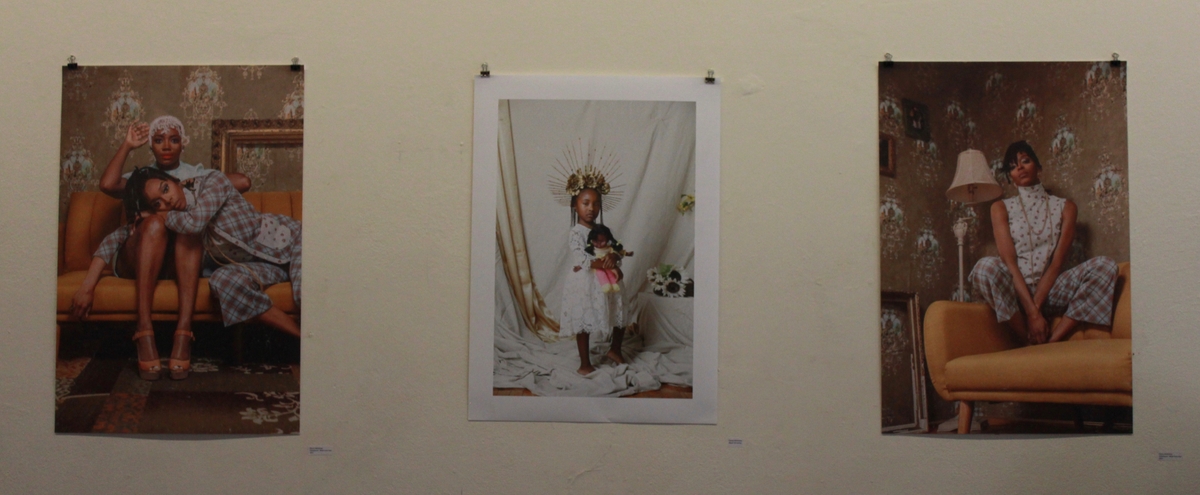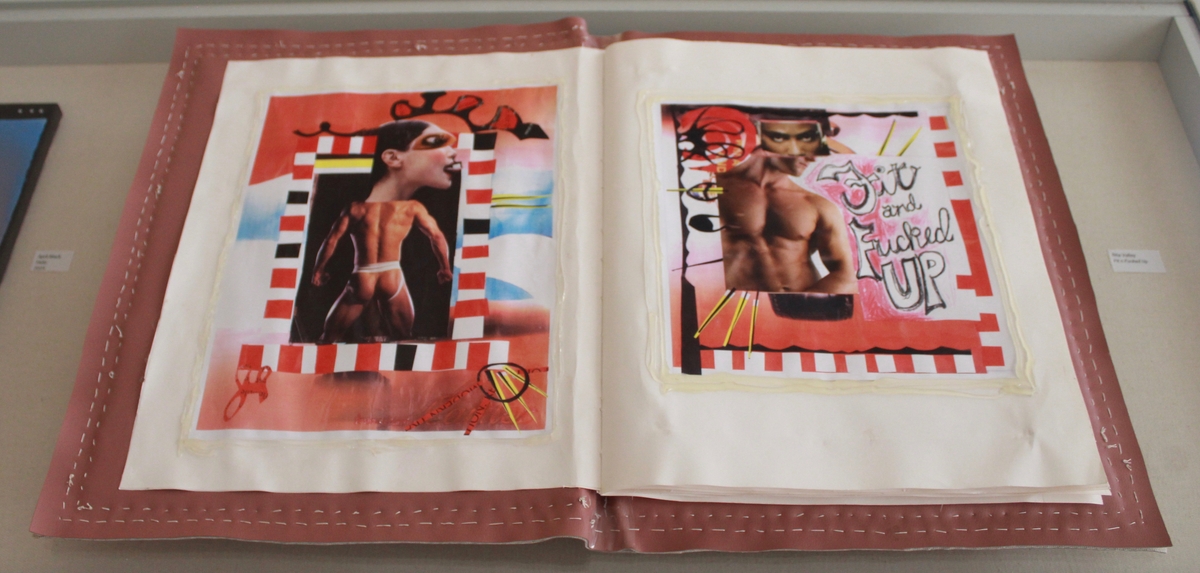
Portrait of a Lady — Spilling the Tea; La Artillería De La Reina — Gimme My Flowers Now; Nefertiti of House Nubia — Bamboo Earring Only 1 Pair.
Sandy Clafford’s trio of paintings take over the space near the window of the Institute Library’s upstairs gallery for the show “Look Book” — running now through May 23 in the Chapel Street library, with an opening reception tonight. They make a bold fashion statement, though not one that follows easy rules.
Luscious prints and corsets collide with triangular glasses and towering flat-tops. The three women pictured are unapologetic in their individualism, flaunting a personal style so deep they could only have made it themselves, with an energy high enough to break the frame around them. That DIY fervor runs throughout the show, curated by Martha Lewis and Maxim Schmidt, which both critiques and revels in the myriad ways in which we use clothing to present who we are, and perhaps who we want to be, to the world.
Lookbooks are a series of images that express a specific aesthetic, the curators write. They can be made to show the work of a single model or artist, or to showcase an entire clothing line. “Often used as a kind of diary, lookbooks distill the zeitgeist of fashion for a particular year, month or season, showing texture, color, lighting, attitude, atmosphere and cultural influences.”
“The importance of how we dress, how we present ourselves in the theater of the street, and what we project is related deeply to agency, self-identity, and to our desires to belong, fit in or stand out from the crowd,” they continue. How we dress can “speak of class aspirations, political alignments (think long red ties or white pantsuits), ethnic and religious identity, and our desire to be desirable within one arena or another, including as a counter-cultural statement.”
“Here at the gallery, we seek a more nuanced, inclusive, and positive take on fashion by offering a different, homemade vision that reflects ourselves and our own ideas of beauty, strength and glamor. With this exhibit we show ourselves as the makers, not just the bearers of meaning. This is about ownership and self-presentation, how we would like to be seen.“
The spark for the show, Lewis said, came from thinking about an exhibition at the Institute Library for Women’s History Month, and thinking about Catherine McKinley’s The African Look Book, after Lewis spoke with the author. McKinley had dived deep into African fashion in the 1960s and 1970s, which led her to explore “colonial times, where woman are being objectified, treated as exotics, weird sexual objects,” Lewis said. In the book is “a collection of very uncomfortable images … of young women who do not, obviously, want to be photographed.” These are juxtaposed with images from the 1970s, “and they’re wearing pantsuits and about to go out for a night on the town.”
The difference in tone was striking, and it got Lewis thinking about the famous Laura Mulvey quote about the male gaze, about how it makes women “the bearers and not the makers of meaning” — and how that can be reversed. In the postcolonial images in The African Look Book, women were getting pictures taken of themselves, taking ownership of their own image, and broadcasting it to others. “There was an attitude about it that I really loved,” Lewis said.

Lewis and Schmidt.
She took the idea to co-curator Maxim Schmidt, and they began talking about how to “expand the idea beyond just women” to encompass queerness and maleness. “This can still be a Women’s History Month show while also widening the reach of what that means, because there are so many ways you can interpret the power of a look book.” Schmidt said. “We added a layer to it.”
The topic, for Schmidt, hit close to home. As he writes in a personal statement accompanying the show, “clothing has always been a crucial part of me existing as myself, fully Maxim; using my presentation as a source of empowerment has been essential in my fostering self-love as a trans person.
“Many of the most pivotal moments in my journey of self-discovery came from clothes — my first tie (a red tie I would regularly don with equally-bright suspenders), my first chest binder, my first suit. Even as I was coming into my own as a queer teenager, I had invented a ‘Friday Tie Day’ tradition where I wore a different tie to school each Friday. Even such a silly practice ended up bridging the social gap I had with my classmates around my being queer, and also gave me the incentive to keep pushing into what felt like ‘me.’
“Now, 10 years of being Maxim later, I still have that same curiosity and excitement around clothes and fashion.… I feel so embodied in my gender now that I am able to revisit things like dresses and skirts without dysphoria. I am able to keep experimenting and playing, unveiling more of myself as I try different things, different versions of myself on. Lys Guillorn’s piece here in ‘Look Book’ in particular resonates with me — I continue to try things on, to grow into being Maxim as I grow into life.”

Guillorn’s knitted piece declares that “I’m still trying things on,” while the entire piece illustrates the ongoing creation and destruction in that process. The needles suggest the piece is still being made. The loose ends dangling from the bottom are unfinished business, and suggest the whole thing could unravel. There’s humor there, but also something of a tightrope. It colors the pieces around it in intriguing ways.
A splendid piece of clothing from Tea Montgomery, the powerful images from Mistina Hanscomb’s Phenomenal Women series, and Clymenza Hawkins’s Arise in Bliss all have a sense of power and triumph about them, but Guillorn’s piece reminds us to be sensitive to how hard the struggle might have been to get there, and the possible tenuousness of the results.
“Owning ourselves and shining it out into the world, in what we wear and who we are, is a freedom we all deserve. What we wear can be a true statement of who we wish to be seen as in the world, and harnessing that power can be life changing,” Schmidt concludes.
The inclusive also mattered to Lewis because “right now we’re doing a really good job of self-selectively splintering ourselves into factions” by “identifying as this or that. I wanted something that allowed people to celebrate who they are and how they are and also bring them together.… I want everyone to be able to be themselves fully, and also for us to be an ‘us.’ ”
And “people are constantly evolving and changing and shifting,” Lewis said. That extends to clothing choices, Schmidt said, as this “ever-evolving, amorphous concept.”
“It’s the living theater of the street,” Lewis said.

Sisterhood — What Once Was; Black Girl series.
Ebony McKelvey’s striking photos remind us that, in fashion, the theater of the street is shaped by several forces at once, from the powers of commercialism and economic opportunity, to the desires of people to express themselves, their culture, and their history and perhaps innovate in the way they look. These forces don’t have to be opposed. It’s possible to make art that’s commercial. But some people show you who they are by crafting their own look from head to toe.
Lewis’s interest in the DIY elements of fashion began young. “Every day upon arrival at nursery school — a casual affair in the basement of a local church — my friend Sarah and I would carefully put on our chosen uniform to start the day: a green satin evening dress, a puffy sleeved bride gown and matching red plastic firefighter helmets, bills facing forward like baseball hats. The solemn sartorial routine allowed us to get to work,” she writes in an accompanying statement. “What interests me, looking back, was that we selected this regalia ourselves, knowing little about the cultural significance of what we were choosing.”
She learned to sew and make clothes, which also meant learning to rework clothes. “As a family without lots of money I wore lots of hand me downs and was adept at patching and reworking. I liked having the older kids clothes, and making them mine. I still love vintage and scoring a find. I also collect and keep for ages things I really like. New purchases frequently tend to be updated versions of something that has worn out.”

Rita Valley
Fit n Fucked Up.
But Lewis also found herself trapped in the world of appearances, as are we all. “I won’t say that as a young woman societal norms about fashion and beauty haven’t screwed with my head at times — they have. I wore clothes that signaled more grown-up ideas than I understood and was treated in ways I was not prepared for. I thought I was ‘supposed’ to be this or that and that it would provide some sort of happiness it could not. I have worn the ‘wrong thing’ and been ostracized and not had the ‘right’ brand or style.”
Few pieces in the show tackle this head-on like Rita Valley’s book Fit n Fucked Up, which uses collage to hilarious and excoriating effect, both pointing out how ludicrous the expectations that fashion places on people can be, while also chronicling how real the damage from trying to meet those expectations can be.
“The good news was I was also taught a scorn for such status games,” Lewis continues. “That being counterculture and DIY were way cooler and satisfying than any brand or mass produced item could deliver,” she writes.
Lewis and Schmidt were also keen to include the environmental aspects of fashion, and the ways the fashion industry contributes to — and could ameliorate — the climate crisis.
“Fast fashion is one of the scourges, and the way that we ship our unwanted things over to the developing world has ruined the textile industry in Africa, for instance,” Lewis said. The DIY approach to fashion, in addition to being a highly individual mode of expression, is a pushback against both of those things. “A more do-it-yourself, vintage, thrift, repurposing” attitude toward fashion can be “economically fair, open to everybody.”
It can also lead to better-quality clothes. The idea of haute couture, of high-end, handmade clothes, is “dwindling,” Lewis said. “It’s harder and harder to get handmade lace. People don’t even have the skill set” anymore, “and the cost is so prohibitive.” But meanwhile, “companies save money on things like thread, which means the clothes fall apart, which means you buy more clothes,” Lewis said. “Things that I have sewn by hand cost a fair amount, because I am buying fabric at a retail store and then making the thing. But they last forever.” She has clothes made by her grandmother that she still wears.
But the DIY approach can split the difference between cheap, mass-produced clothes and skillfully made high-fashion pieces or heirlooms, breathing new life into old pieces of clothing.
“With the environmental pieces” in the show, Schmidt said, “there is this bodily, corporeal connection to nature,” a “fusion” of the “presentation of the sense of self” with “the environment. There is a quality in each of these that connects to the body and to nature that bridges the gap.”

Yellow Bag, by Alan Neider.
The repurposing of scrap clothes ends, perhaps, with Alan Neider’s art. His studio, Schmidt related, is a mountain of things that he has found from thrifting. “It’s making sure that the things that can’t be recycled in other ways are then repurposed.”
“They still have a life,” Lewis said.
“Look Book” runs at the Institute Library, 847 Chapel St., through May 23. Its opening reception, tonight, March 21, is from 6 to 8 p.m. and features special guest of honor Antoinette Brim Bell, poet laureate of Connecticut. April 25 features a book talk on fashion and fascism. May 23’s closing reception features a shoe-based puppet show by Kimberley van Aelst. Visit the library’s website for hours and more information.

Thank you for this article! It's really an amazing luxury in this day and age to have such thoughtful and deep arts coverage.